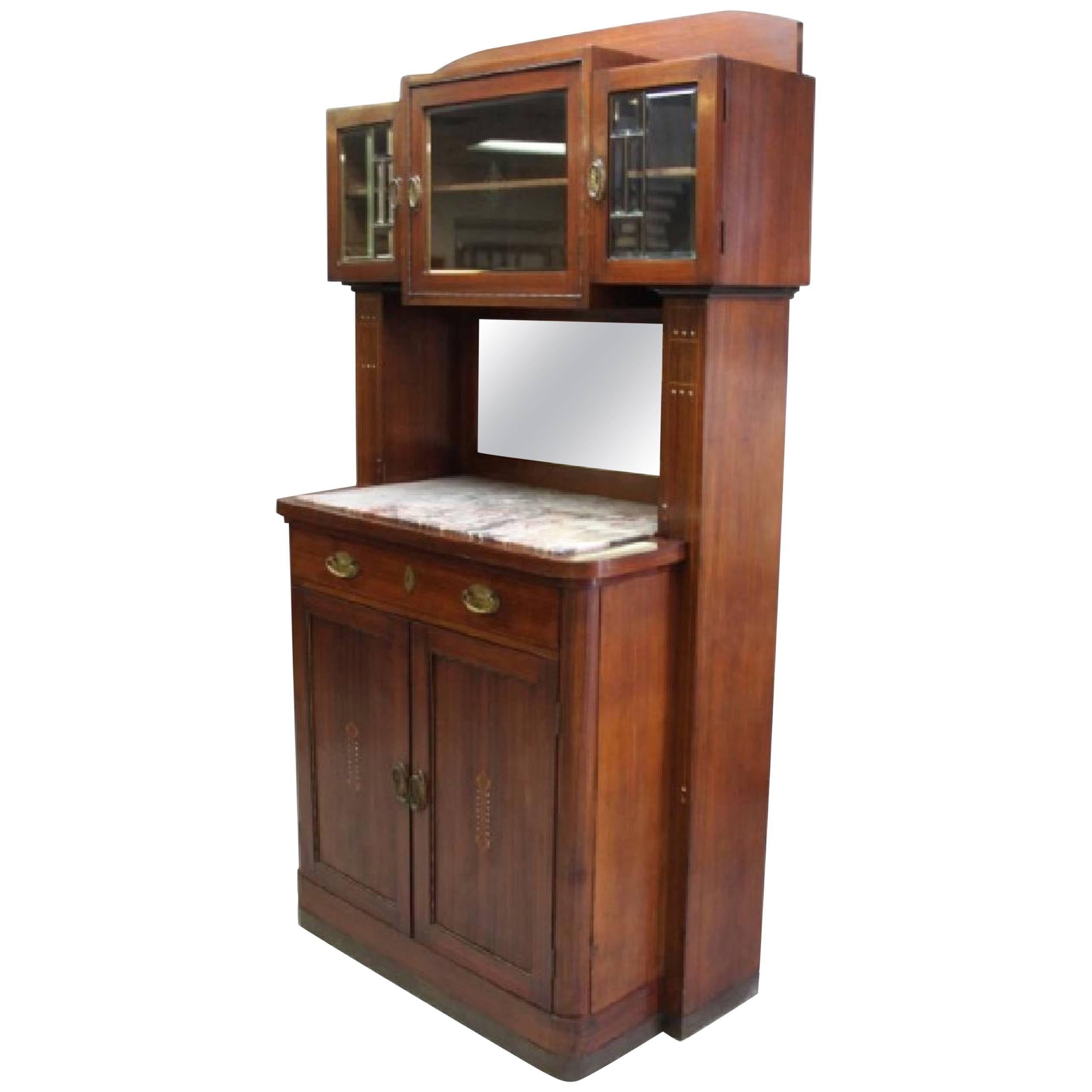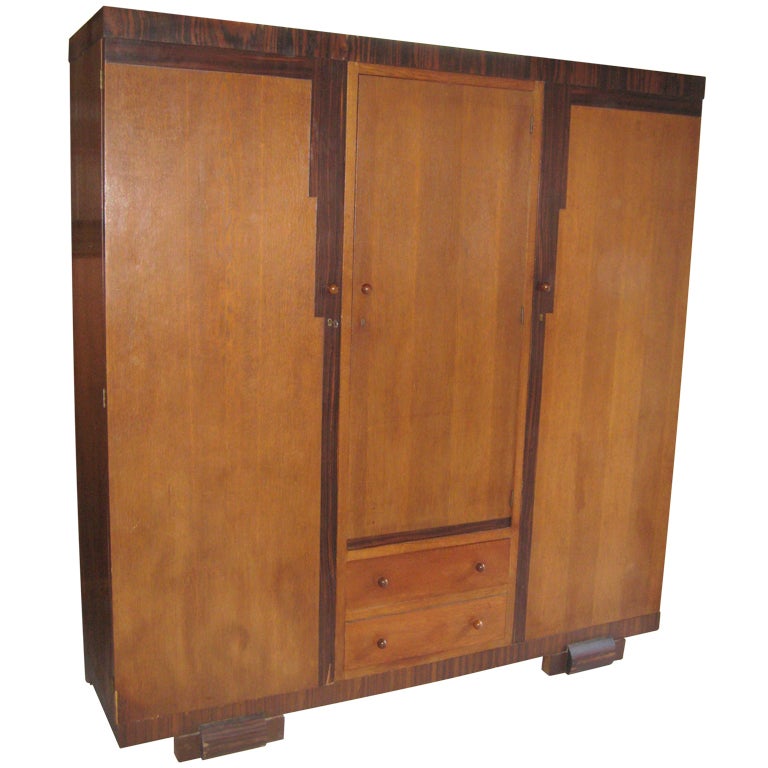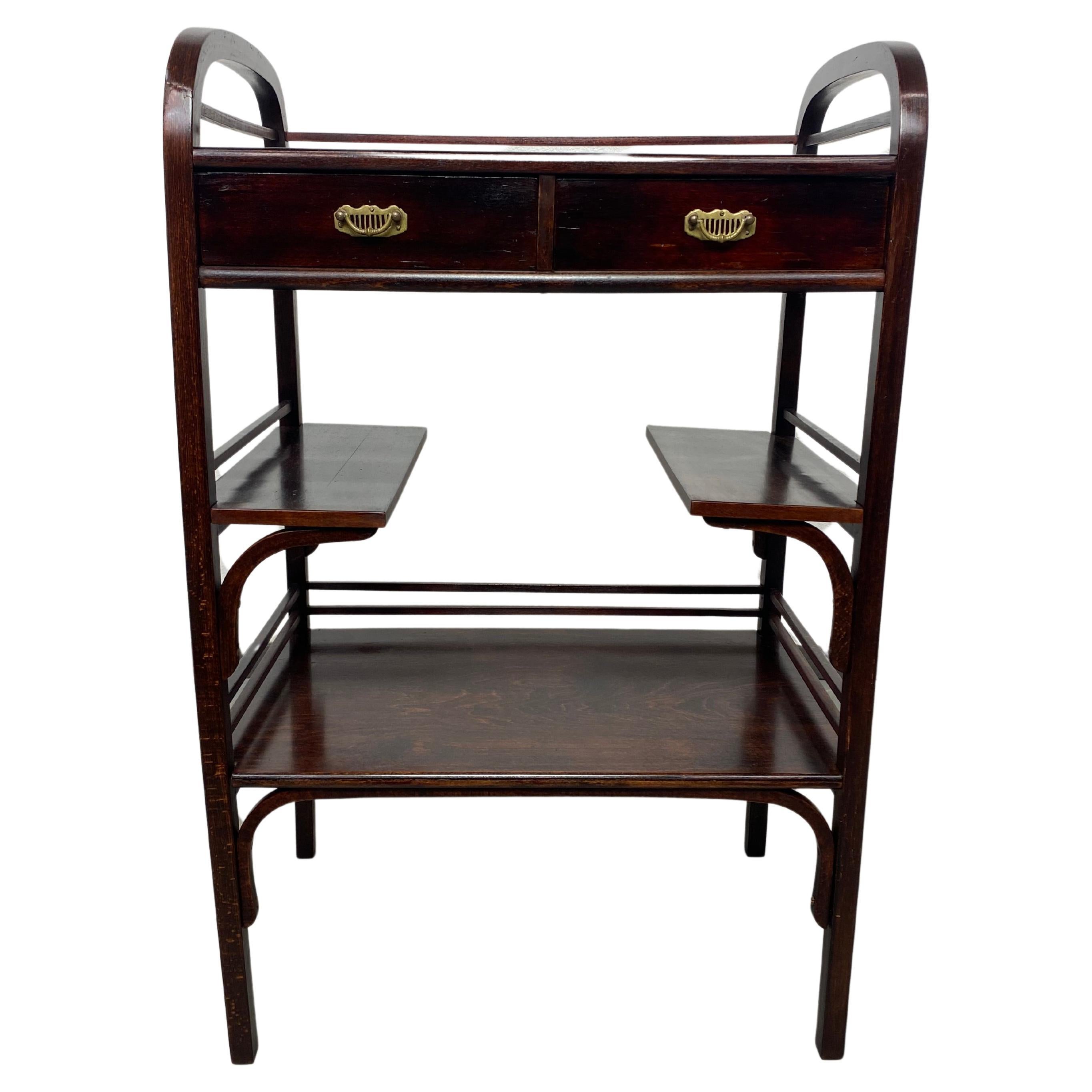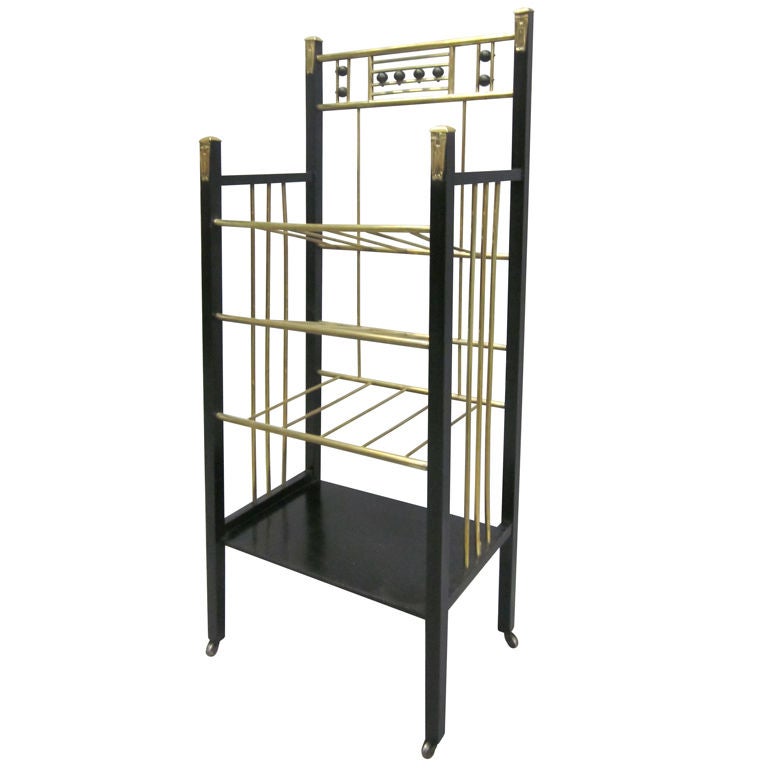Items Similar to Furniture for Havana Cigars, Puros, Attributed to Koloman Moser and Werkstatte
Video Loading
Want more images or videos?
Request additional images or videos from the seller
1 of 9
Furniture for Havana Cigars, Puros, Attributed to Koloman Moser and Werkstatte
About the Item
Furniture for havana cigars, puros, attributed to Koloman Moser and Wiener Werkstatte.
Material: wood
Style: Vienna Secession
Country: Vienna
If you have any questions we are at your disposal.
Pushing the button that reads 'View All From Seller'. And you can see more objects to the style for sale.
Moser was born in Vienna in 1868 and studied design and painting at the Academy of Fine Arts in his home city from 1885 till 1892, and then graphic design at the School for Applied Arts until 1895, where he subsequently became a teacher in 1899 and received his professorship one year later.
In 1897, Moser had joined Josef Hoffmann, Otto Wagner, Adolf Loos, Joseph Maria Olbrich and Gustav Klimt as co-founders of the Weiner Secession, and in 1903, together with Josef Hoffmann and the industrialist Fritz Waerndorfer, he co-founded the Wiener Werkstaette, based on the British Arts and Crafts Movement.
Moser was active in all branches of applied art, including painting, graphic design, furniture, metalwork, fabrics, book covers, jewelry and, of course, glass
The Wiener Werkstätte was founded in 1903 by Koloman Moser and Josef Hoffmann, both of whom had been key members of the Vienna secession. The primary goal of the company was to bring good design and craft into all areas of life within the fields of ceramics, fashion, silver, furniture, and the graphic arts.
Why are there so many antiques in Argentina?
In the 1880 – 1940 there was a grate wave of immigration encouraged by the periods of war that were taking place.
1st World War took place between 1914 and 1918
2nd World War took place between 1939 and 1945
The immigrants options were New York or Buenos Aires. Tickets were cheap and in Buenos Aires they were welcomed with open arms, as it was a country where everything was still to be done.
Argentina was the country of new opportunities, labour was needed and religious freedom was assured, in many cases the of the family travel first until they were settled and then the rest of the family members join them.
In the immigrant museum “Ellis Island Immigrant Building” in New York you can se the promotional posters of the boats that would take them to a new life.
Between the years 1895 and 1896, Argentina had the highest DGP (gross domestic product) per capita in the world according to the Maddison Historical Statistics index, this situation arose due to the large amount of food being exported to European countries, which were at war.
The Argentinean ships left the port of Buenos Aires with food, but they returned with furniture, clothes and construction elements, (it´s common to see this the old buildings of the historic neighbourhood of San Telmo, the beams with the inscription “Made in England)”, as well as many markets that were built in Buenos Aires, such us the San Telmo Market, whose structure was brought by ship and afterwards assembled in 900 Defensa Street.
With the great influence of European immigrants living in the country, the children of the upper classes travelled to study in France, resulting in the inauguration of “La Maison Argentinienne”, on 27th of June 1928, in the international city of Paris, which hosted many Argentinians that were studying in Frace.
It´s the fourth house to be built after France, Canada and Belgium, being the first Spanish-speaking one. Still in place today (17 Bd Jourdan, 75014, Paris, France). Many of the children of these wealthy families who attended international art exhibitions, museums and art courses abroad, took a keen interest in the European style. This is why Buenos Aires was at the time referred as “The Paris of South America”.
Between the years 1890 and 1920 more than a hundred Palaces were built on Alvear Avenue the most exclusive avenue in Buenos Aires. Today some of these palaces have been transformed into museums, hotels and embassies.
In the year 1936, the Kavanagh building was inaugurated, it was the tallest reinforced concrete building in South America.
During 1994 the American Society of Civil Engineers distinguished it as an “international engineering milestone”, and it´s now considered a World Heritage of Modern Architecture.
At the time was common to hire foreign architects such as Le Corbusier, who visited Buenos Aires/Argentina in 1929 and in 1948 he drew up the blueprints for a house built in La Plata City (which was declared a World Heritage Site).
In 1947, the Hungarian architect Marcelo Breuer designed “Parador Ariston” in the seaside city of Mar del Plata. After an Argentinean student at Harvard University convinced him to come to Argentina. He worked on an urban development project in the Casa Amarilla, area of La Boca.
The Ukrainian architect, Vladimiro Acosta, arrives in Argentina in 1928 and worked as an architect until que moved to Brazil.
Antonio Bonet, a Spanish architect who worked with Le Corbusier in Paris, arrives in Argentina in 1937, where he carried out several architectural works and in 1938 designs the well-known BFK chair.
Andres Kálnay, of Hungarian origin, made around 120 architectural masterpieces, among which the former Munich brewery stands out, he even made the furniture’s design.
The German architect, Walter Gropius, director of the Bauhaus, lived in Argentina, where he wrote articles for “Sur” magazine and founded in Buenos Aires, an architectural firm with Franz Möller, who was also an architect, where he built two houses.
At the same time several famous designers decided to immigrate to Argentina, among them we can find the well-known French designer, Jean-Michel Frank, who arrived in the country in 1940 and also worked for the Rockefeller family.
Special pieces were made, which were sold exclusively in the country, such as the well-known German company “WMF”, who sold their products by catalogue, which were chosen by the ladies of high society in the list of wedding gifts, as well as the pieces designed by Christofle.
The Swiss sculptor Alberto Giacometti, made special pieces for Argentinean mansions.
In 1904 the first Jansen branch outside Paris was established in Buenos Aires, as the Argentinean clientele demanded a large amount of furniture, from the end of the 19th century to the mid-20th century.
In 1970, the brand Rigolleau Argentina made pieces authorised by Lalique.
The brands Maple and Thompson also set up shop in the country.
The French plastic artist, Marcel Duchamp moved to Argentina in 1918-1919.
Glass signed Gallé, Charder, Leverre, Schneider, Muller and other French firms. They were bought in flower shops and were given to ladies with beautiful floral arrangements.
Some furniture manufacturers travelled to international fairs and bough the patterns to produce the furniture in Argentina, such as the furniture firm Englander and Bonta, who bought the patterns ins Italy.
It is worth mentioning that in Argentina we have the largest community of Italians outside of Italy, as it is estimated that 70 percent of the inhabitants have at least one Italian descendant, followed by Spanish immigrants.
The most Important furniture stores in Argentina:
Comte is founded in 1934 (under the direct management of Jean Michel Frank in 1940).
Nordiska (Swedish company established in 1934).
Churba in 1960, a company that brought foreign designers to present their furniture in the country:
Denmark: (Arne Jacobsen, Finn Juhl, Bender Madsen, Ejner Larsen, Poul Kjaerholm, Hans Wegner)
Sweden: (Hans Agne Jakobsson, Gustavsberg)
United States: (Herman Miller)
Finland: (Lisa Johansson, Folke Arstrom, Tapio Wirkkala, Alvar Aalto, Timo Sarpaneva)
Swedish Factory: (Orrefors)
Italy: (Littala, Vico Magistretti, Emma Gismondi, Gae Aulenti, Angelo Mangiarotti, Elio Martinelli, Gianna Celada, Angelo Mangiarotti, Mario Bellini, Carlo Scarpa)
Finland: (Olivia Toikka)
Plata Lappas (Lappas Silver): a goldsmith shop founded in 1887 in Argentina by Alcibiades Lappas of Greek origin.
In 2019, in Argentina took place “the Art Deco world congress”, in which we participated as hosts invited by Geo Darder, founder of the Copperbridge – Foundation, in which prominent people from all over the world attended to learn about Art Deco in Argentina.
Argentina currently has more than 100 Art Deco buildings and another 90 Art Nouveau buildings throughout the city of Buenos Aires.
Argentina is a country that has not been involved in many wars, which is why it has been a refuge for works of art and antiques from different periods of time, unlike European countries. That is way many collectors, museums and antique dealers from all over the world visit it, you should not miss the opportunity to visit this great country.
Laura Guevara Kjuder, architect.
- Attributed to:Koloman Moser (Designer)
- Dimensions:Height: 63 in (160 cm)Width: 15.75 in (40 cm)Depth: 31.5 in (80 cm)
- Style:Vienna Secession (Of the Period)
- Materials and Techniques:
- Place of Origin:
- Period:1900-1909
- Date of Manufacture:1908
- Condition:Wear consistent with age and use.
- Seller Location:Ciudad Autónoma Buenos Aires, AR
- Reference Number:
About the Seller
5.0
Vetted Seller
These experienced sellers undergo a comprehensive evaluation by our team of in-house experts.
Established in 1982
1stDibs seller since 2022
23 sales on 1stDibs
Typical response time: <1 hour
- ShippingRetrieving quote...Ships From: Ciudad Autónoma Buenos Aires, Argentina
- Return PolicyThis item cannot be returned.
More From This SellerView All
- Murano 1940, Attributed to Flavio Poli, ItalianBy Flavio PoliLocated in Ciudad Autónoma Buenos Aires, CMurano We have specialized in the sale of Art Deco and Art Nouveau and Vintage styles since 1982. If you have any questions we are at your disposal. Pushing the button that reads 'V...Category
Vintage 1940s Italian Art Deco Tobacco Accessories
MaterialsMurano Glass
- Murano, 1930, Italian, Attributed to Paolo Venini Technique PelegosoBy Paolo VeniniLocated in Ciudad Autónoma Buenos Aires, CMurano We have specialized in the sale of Art Deco and Art Nouveau and Vintage styles since 1982. If you have any questions we are at your disposal. Pushing the button that reads 'View All From Seller'. And you can see more objects to the style for sale. Venini ( Technique Pelegoso ) Pelegoso technique A type of glass characterized by countless irregular air bubbles (pulighe) within the vitreous wall, which deliberately obscure its transparency. It is obtained by pouring substances such as petrol into the pot, which produce a boiling over of the glass in fusion. Attributed to Venini Early life and education Venini was born in the town of Cusano near Milan, Italy. After serving in the Royal Italian Army in World War I, he trained as a lawyer and began his practice in Milan. He soon developed an acquaintance with Giacomo Cappellin, a native of Venice who owned a Milan antiques...Category
Vintage 1930s Italian Art Deco Ashtrays
MaterialsMurano Glass
- Cabinet to Collect Coins or Medals with Drawers in Wood, French 1930 Art DecoLocated in Ciudad Autónoma Buenos Aires, CCabinet to collect coins or medals with drawers Year: 1930 Country: French Materials: Wood Finish: polyurethanic lacquer It is an elegant and sophis...Category
Vintage 1930s French Art Deco Dressers
MaterialsWood
- Furniture in Wood, Art Deco, "Attributed to Louis Süe and André Mare", 1930By Andre MareLocated in Ciudad Autónoma Buenos Aires, CAmazing bookcase Art Deco Style: French We have specialized in the sale of Art Deco and Art Nouveau and Vintage styles since 1982.If you have any questions we are at your disposal. Pushing the button that reads 'View All From Seller'. And you can see more objects to the style for sale. Attributed to Louis Süe and André Mare Louis Süe (14 July 1875 – 7 August 1968) was a French painter, architect, designer and decorator. He and André Mare co-founded the Compagnie des arts français, which produced Art Deco furniture and interior decorations for wealthy customers. He also designed buildings and interiors, including the interiors of two passenger liners. Marie-Louis Süe was born on 14 July 1875 in Bordeaux. He was the grand nephew of the writer Eugène Sue.His father was a wine merchant. After graduating from secondary school he entered the Collège Sainte-Barbe in Paris to prepare for the École Polytechnique. However, in 1893 he left Sainte-Barbe and entered the École des Beaux-Arts where he studied painting in the studio of Victor Laloux (1850–1937). During this period he also explored architectural design, and was awarded medals for his work. He gained his diploma in 1901. Süe made friends at the Beaux-Arts with the painters Pierre Bonnard, Roger de La Fresnaye, André Derain and André Dunoyer de Segonzac. In 1902 the Salon des Indépendants and the Salon d'Automne showed his work. Süe's work always combined an understanding and respect for traditional forms with a willingness to explore the new. n 1919 Süe and André Mare founded the Compagnie des arts français (French Arts Company) and in 1921 published their first designs of furniture, wallpaper, tapestries, silverware and ceramics. The company employed many artists and craftsmen to meet the needs of their sophisticated and wealthy clientele for interior decoration. The Metropolitan Museum acquired examples of their furniture as early as 1923. Their Art Deco works, typically with flower designs, were both elegant and practical. Süe and Mare decorated interiors such as the Polish Embassy in Paris and the home of Jean Patou.[2] In their joint work Architectures (1921) Sue and Mare asserted that Art Nouveau was based on a synthesis of fine and decorative arts. Their commercial designs often had simplified forms with rich materials. In 1922 Süe designed the industrial town of Lens-Méricourt for the French Northern Railway company.[1] In 1922 the Compagnie des arts français obtained financial support from Gaston Monteux, owner of the Raoul shoe firm.Süe and Mare worked together again for the 1925 International Exposition of Modern Industrial and Decorative Arts in Paris, where they built a contemporary art museum and the Fountain pavilion on the Esplanade des Invalides. They showed a luxurious room in the grand salon with furniture, carpet, wallpaper and decorations in new forms linked to traditional designs.They also collaborated that year on the interior decoration of the SS Île de France...Category
Vintage 1930s French Art Deco Bookcases
MaterialsGlass, Wood
- Sconce attributed to Mouille SergeBy Serge MouilleLocated in Ciudad Autónoma Buenos Aires, CSconce To take care of your property and the lives of our customers, the new wiring has been done. If you want to live in the golden years, this is the Wall light that your project needs. We have specialized in the sale of Art Deco and Art Nouveau styles since 1982. If you are looking for sconces to match your ceiling lighting, we have what you need. Pushing the button that reads 'View All From Seller'. And you can see more objects to the style for sale. Serge Mouille Instantly recognizable by their long slender armatures and domed, ovoid shades, the best-known floor lamps and other lighting fixtures of Serge Mouille have become emblems of the organic design of the mid-20th century. Along with Jean Prouvé, Mathieu Matégot and others, Mouille brought a fresh, modern aesthetic to metalwork, one of the most tradition-bound mediums in the decorative arts. Mouille (pronounced: MWEE) was born to a working Parisian family. At age 15, he took up studies in the metalworking atelier of that École des Arts Appliqués, under the tutelage of the goldsmith and sculptor Gabriel Lacroix. After graduating, in 1941, Mouille worked in Lacroix’s studio and began teaching at his alma mater four years later. In the early 1950s, bothered by the preponderance of new Italian lamps and chandeliers on the market and consumed with the belief that fixtures by Gino Sarfatti and others were unnecessarily complex, Mouille opened a lighting-design workshop. He quickly won commissions from several French schools and libraries. In 1956, the influential Paris gallerist Steph Simon — who also promoted Prouvé, Charlotte Perriand and Isamu Noguchi — began to show Mouille designs, introducing his work to private collectors. Mouille would continue making handcrafted lighting fixtures at a slow but steady pace until 1964, when he stopped working to begin a long course of treatment for tuberculosis. When it was completed, Mouille returned to teaching at the École des Arts Appliqués for the remainder of his career. With the biomorphic shades and long armatures of his fixtures, Mouille created one of the most engaging and idiosyncratic lighting aesthetics of his time. Though often described as “insect-like,” his pieces have more in common with the fluid, buoyant forms in the paintings of Jean Arp. (Mouille designed several cylindrical or columnar lamps; though highly collectible, those are interesting outliers in his body of work.) As with Prouvé’s folded...Category
Vintage 1930s French Space Age Wall Lights and Sconces
MaterialsAluminum, Steel
- Murano and gold, Italian, Attributed to, Seguso Barovier, 1930By Barovier Seguso & FerroLocated in Ciudad Autónoma Buenos Aires, CMurano We have specialized in the sale of Art Deco and Art Nouveau and Vintage styles since 1982. If you have any questions we are at your disposal. Pushing the button that reads 'View All From Seller'. And you can see more objects to the style for sale. The history of "Seguso Vetri D' Arte" is directly linked to the "Vetreria Artistica Barovier" company. When the Barovier workshop was forced to reduce production in 1929, due to a financial crisis in America, the original group of ten partners had to separate and Antonio Seguso in 1931, assisted by his sons Ernesto and Archimede opened a small workshop of his own. They were joined by Luigi Olimpio Ferro and Napoleone Barovier the following year. Together the craftsmen establish the "Artistica Soffieria e Vetreria Barovier Seguso & Ferro" company as equal partners. In 1934 Flavio Poli joins the firm as artistic director and within only a brief period of time a distinct style of designs emerged. The close collaboration between Flavio Poli, Archimede Seguso and Alfredo Barbini played an important part in the success of the company. New glass techniques are developed which include never before seen color applications. The companies innovative designs constantly received awards and during the 1935 World Fair in Brussels and the 1936 Milan Triennale they did attract the interest of a new group of clientele. One of them is the French wholesale company "Veronese" from Paris which would play a defining role in the history of the company. The demand for an increase in production requires additional investments and the partners felt that there is a need to multiply their investment tenfold. Luigi Olimpio Ferro subsequently decided to withdraw from the company and his shares are acquired by Flavio Poli, which makes him a full partner. As a result, the company name is changed to Seguso Vetri D’ Arte and it is officially recognized in 1937. A period of great success and prosperity ensues, lasting until the outbreak of World War II. The post war period is a time of great change in Europe and the rebuilding of the economical structure in Italy requires major investments which result in the introduction of new import duties and taxes. To safeguard the copyright of the Seguso Vetri D'Arte designs an application for a second entry into the commercial registers of Venice is made by the partners in 1945. Strict export regulations curb international business relations for many years after the war and the company decides to focus on the domestic market instead. In 1946 a large retail location is opened at the Piazza Diaz in Milan where in addition to the art glass, German porcelain and Italian pottery is offered. In 1950 Flavio Poli develops a new sommerso glass technique, which consists of an overlaying of transparent layers of glass. The overlapping creates new shades of color which prior to the introduction of this technique had not been seen. Flavio Poli's most iconic design is the "Valve", which resembles an upright, slightly opened clam shell. The design was introduced in 1951. Mario Pinzoni joins the company in 1953 as a personal assistant to Flavio Poli and his responsibilities as a draftsman included the compilation of archival and the existing production drawing s...Category
Vintage 1930s Italian Art Deco Ashtrays
MaterialsGold
You May Also Like
- Viennese Secessionist Sideboard, Attributed to Koloman MoserBy Koloman Moser, J.W. Müller, Wenzel HollmannLocated in West Palm Beach, FLViennese Secessionist Sideboard, Attributed to Koloman Moser Austria, circa 1905 Presenting a remarkable piece of Viennese Secessionist design, this tall sideboard or drawing room c...Category
Antique Early 1900s Austrian Vienna Secession Sideboards
MaterialsMarble, Brass
- Wall shelf by Koloman Moser for Wiener WerkstätteBy Wiener Werkstätte, Koloman MoserLocated in Banská Štiavnica, SKWall shelf by Koloman Moser for Wiener Werkstätte in very good original condition.Category
Antique Early 1900s Austrian Vienna Secession Shelves
MaterialsWood
- Wiener Werkstatte Armoire Attributed to Josef HoffmannBy Wiener Werkstätte, Josef HoffmannLocated in Brooklyn, NYRare signed piece of Wiener Werkstatte furniture in beech with Macassar Ebony inlay. The "Wierner Werkstatte of America" insignia dates thi...Category
Early 20th Century Austrian Vienna Secession Wardrobes and Armoires
MaterialsBeech, Macassar
- Vienna secession etagere atr. to Koloman Moser and Otto Wagner ex. by J&J KohnBy Koloman Moser, Otto Wagner, Jacob & Josef KohnLocated in Banská Štiavnica, SKVienna secession bentwood etagere atr. to Koloman Moser and Otto Wagner ex. by J&J Kohn in very good original condition.Category
Vintage 1910s Austrian Vienna Secession Shelves
MaterialsBrass
- Original of the Time Marked "Wiener Werkstätte" Koloman Moser Bookcase / CabinetBy Woka Lamps, Koloman Moser, Wiener WerkstätteLocated in Vienna, ATVery rare cabinet from the short period when the Wiener Werkstätte has had its own cabinet makers workshop in the Neustiftgasse in Vienna. Attributed to Koloman Moser or Emanuel Margold. Punched locks and original key! Literature: Sotheby's Fine 20th century design, catalogue May 2007. Materials & Techniques Notes: limed oakwood with silver filled vein - so called Silbereiche - which Josef Hoffmann and Koloman Moser used...Category
Early 20th Century Austrian Jugendstil Vitrines
MaterialsOak
- Viennese Secession Etagere / Magazine Stand in the Style of Koloman MoserBy Koloman MoserLocated in New York, NYAn exquisite early 20th century ebonized wood etagere / magazine stand / bookcase that suits any contemporary or traditional environment. The etagere / magazine stand has a pure, sober form with elegant brass rod shelves and supports. Subtle detailed brass caps finish the piece along with a modern crest at the top composed of brass rods with ebonized black balls.Category
Early 20th Century Austrian Vienna Secession Shelves
MaterialsBrass
Recently Viewed
View AllMore Ways To Browse
Antique Furniture For
Antique French Furniture Antique Furniture
French Furniture Antique Furniture
Large Antique Furniture
Fine Furniture Antique Furniture
Mid Century Antique Furniture Antique Furniture
Mid Century Furniture Antique Furniture
Antique Italian Furniture Furniture
French Style Furniture Antique Furniture
Antique Furniture Old Furniture
Antiques Furniture Antique Furniture
Transformable Furniture
Antique To Modern Furniture
Furniture Dealers
Find Antique Furniture
Famous Antique Furniture
French Furniture Origin
Italian Furniture Manufacturer





